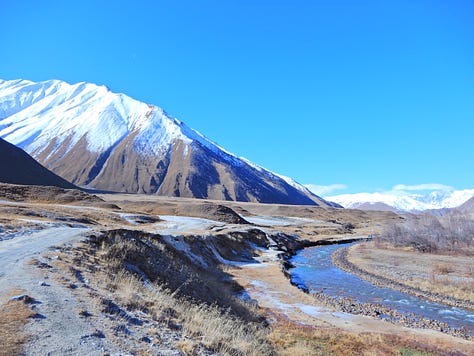Zen in Ten: "Water Is the Palace of the True Dragon"
Eihei Dōgen's Wisdom on Broadening Our Perspectives



Below are some selections from one of Eihei Dōgen’s most famous teachings: “Sansuikyō,” which means “mountains and waters are sutra.” Bowing from the monastery, Rev. Shōren Heather
“Mountains and waters right now are the actualization of the ancient Buddha way. Each, abiding in its phenomenal expression, realizes completeness. Because mountains and waters have been active since before the Empty Eon, they are alive at this moment. Because they have been the self since before form arose they are emancipation realization.”1
“Because mountains are high and broad, the way of riding the clouds is always reached in the mountains; the inconceivable power of soaring in the wind comes freely from the mountains.”2
“Mountains have been the abode of great sages from the limitless past to the limitless present. Wise people and sages all have mountains as their inner chamber, as their body and mind. Because of wise people and sages, mountains appear. You may think that in mountains many wise people and great sages
are assembled. But after entering the mountains, not a single person meets another. There is just the activity of the mountains. There is no trace of anyone having entered the mountains.”3
“Water is neither strong nor weak, neither wet nor dry, neither moving nor still, neither cold nor hot, neither being nor nonbeing, neither delusion nor enlightenment. Solidified, it is harder than diamond: who could break it?
Melted, it is softer than milk: who could break it? This being the case, we cannot doubt the many virtues realized by water.” 4
“We should, then, study that occasion when the water of the ten directions is seen in the ten directions. This is not a study only of the time when peoples or devas see water: there is a study of water seeing water. Water practices and verifies water; hence there is a study of water speaking water. We must bring to realization the path on which the self encounters the self. We must move back and forth along, and spring off from, the vital path on which the other studies and fully comprehends the other.”5
“In general, then, the way of seeing mountains and waters differs according to the type of being [that sees them]. In seeing water, there are beings who see it as a jeweled necklace. This does not mean, however, that they see a jeweled necklace as water.”6
“How, then, do we see what they consider water? Their jeweled necklace is what we see as water. Some see water as miraculous flowers, though it does not follow that they use flowers as water. Hungry ghosts see water as raging flames or as pus and blood. Dragons and fish see it as a palace or a tower, or as the seven treasures or the mani gem. [Others] see it as woods and walls, or as the Dharma nature of immaculate liberation, or as the true human body, or as the physical form and mental nature. Humans see these as water. And these [different ways of seeing] are the conditions under which [water] is killed or given life.”7
“It is not the case simply that there is water in the world; within the world of water there is a world. And this is true not only within water: within clouds as well there is a world of sentient beings; within wind there is a world of sentient beings; within fire there is a world of sentient beings; within earth there is a world of sentient beings. Within the Dharma realm there is a world of sentient beings; within a single blade of grass there is a world of sentient beings; within a single staff there is a world of sentient beings. And wherever there is
a world of sentient beings, there, inevitably, is the world of buddhas and ancestors. The reason this is so, we should study very carefully.”8
“In this way, water is the palace of the ‘true dragon’; it is not flowing away. If we regard it only as flowing, the word ‘flowing’ is an insult to water: it is like imposing ‘not flowing.’ Water is nothing but water’s ‘real form just as it is.’ Water is the virtue of water; it is not flowing. In the thorough study of the flowing or the not-flowing of a single [drop of] water, the entirety of the ten thousand things is instantly realized.”9
“Among mountains as well, there are mountains hidden in jewels; there are mountains hidden in marshes, mountains hidden in the sky; there are mountains hidden in mountains. There is a study of mountains hidden in hiddenness.”10
Translated by Kaz Tanahashi.
Ibid.
Ibid.
Translated by Carl Bielefeldt.
Ibid.
Ibid.
Ibid.
Ibid.
Ibid.
Ibid.




So beautiful and inspiring! Almost wanting to cry reading them. 🤍
Thank you. I'm grateful to find your page. One of my biggest inspirations was reading Crooked Cucumber many years ago and continue to grow because of it. Dogen reminds me of humility and getting out of my own way.